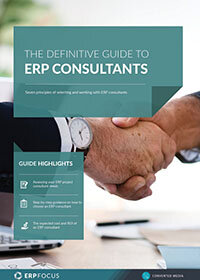2 Ways You Can Match an ERP Consultant with Your Business
In my previous article in this series I discussed ‘why’ one might ‘need’ an ERP consultant, and what conditions might force the purchase decision. However, deciding to hire a consultant, versus the process of actively searching for the ‘right’ person or group, are as dissimilar as oranges and apples, and in the latter case applies directly to the headline of this piece; What you need an ERP consultant for?
The search process associated with finding the right consulting resource at the right time is a typically tedious process rife with paperwork, in and outbound phone calls, and screening interviews. Unfortunately, and to be direct, however, there is no other way to get the job done. Hiring an ERP consultant is not like buying shoes where one needs a pair of black shoes for one suit, and a brown pair to go with another.
The search process associated with finding the right consulting resource at the right time is a typically tedious process rife with paperwork
Securing a trusted business advisor and handing over to a third-party is more like dating, where the parties have to really get to know and like one another before they start living together. In this event, then, here are a couple of general assessment milestones to set the scene for any manager who is about to look for an ERP consultant, while trying to avoid a lengthy lead time from the outset.
Match Business Scale
To start, perhaps the most important ingredient of a successful consultant/client relationship regards the scale match between a potential consultancy and a client firm. This necessity is driven by the fact that large, mid, or small companies face different problems at different times, and consequently require different solutions from their consultants to establish successful problem outcomes. It is a bad idea is to knowingly mis-match ERP consultants and your business since to do so can cause real headaches for both participants down the road.
Recommended Reading - ERP Implementation: 11 Steps to Success
For example, large-scale consultancies like McKenzie Consulting, or Anderson Consulting Group, don’t match well with small enterprises in the annual $1 million – $10 million revenue range, simply because those kinds of consultancies can quickly find themselves over-spending a client’s budget, along with damaging the practical results of the business relationship. So, a good rule of thumb is to match the relative revenue values of each potential participant, in order to avoid the potential of paying for a Ferrari, when a Ford will do just as well.
Match Consulting Experience
There is a general assertion that although many potential ERP consultants can showcase their business value as a trusted advisor, these can still be split into ‘consultants’, and ‘Consultants,’ where the characteristic of ‘looking good’, is not necessarily the same thing as ‘being good’ for a particular client.
When beginning a screening round to establish a consulting relationship one should always review and understand the specifics of a potential consulting resource’s experience. For example, over the last 10 years Professional Accountants have begun to title themselves as ‘consultants’ in the ERP space, without actually understanding all of the practical elements associated with fully-fledged ERP operations.
There is no intent to suggest that these professionals are not competent or are unethical in some way. But there is a considerable difference between an advisor that understands the vagaries of production scheduling, demand inventory management, and integrated cost control, versus a financial number cruncher that keeps a company’s books, does its balance sheet and P/L, and executes its tax returns at the end of the fiscal year. So, when one sets up for consultant screening meetings, be sure that one is talking to the right resource, lest one waste valuable time to no effect.
As asserted earlier, every company is different, just as every consultant is; but when it comes to establishing a successful consultant/client relationship, one may as well stack the deck by making sure that all hands are playing on the same field, using the same rules.
Free white paper

ERP Implementation: 9 steps to success
The 9 proven steps you should follow when implementing ERP

Featured white papers
-

The definitive guide to ERP consultants
Seven principles of selecting and working with ERP consultants
Download
Related articles
-

A case study on finding the right ERP consultant
A fictional case study on the impact of hiring the right ERP consultant
-

Secret KPI: Why Your ERP Implementation Team Matters More Than Software
Learn how Godlan ensures successful ERP implementation for manufacturers with proven strategies &...
-

ERP training, and how to train the trainer
Internal or external training - what would be best for your business?

